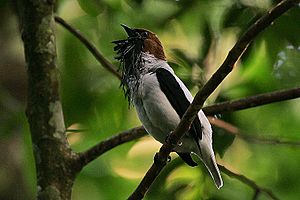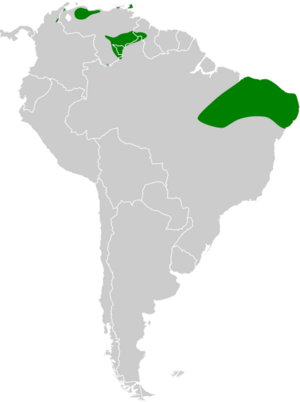Bearded bellbird facts for kids
Quick facts for kids Bearded bellbird |
|
|---|---|
 |
|
| Male calling | |
| Conservation status | |
| Scientific classification | |
| Genus: |
Procnias
|
| Species: |
averano
|
 |
|
The bearded bellbird (Procnias averano) is a special type of passerine bird. It's also known as the campanero or anvil-bird because of its loud, metallic call. You can find this bird in northern South America.
Male bearded bellbirds are about 28 cm (11 in) long. They have mostly white feathers, but their head is brown and their wings are black. Under their chin, they have several black, stringy growths called wattles, which look a bit like a beard!
Female bellbirds are a little smaller. They have an olive-green head and back, with yellow feathers underneath that have green streaks. The area under their tail is bright yellow. The male's call is very loud and sounds like a hammer hitting an anvil.
There are two main types, or subspecies, of the bearded bellbird. One type lives only in northeastern Brazil. The other type is found in Trinidad, Venezuela, Colombia, Guyana, eastern Bolivia, and northern Brazil. These birds live in wet tropical forests. They mostly eat fruit and berries, which they catch while flying. Their nest is a simple structure made of stems and twigs. It's usually built far out on a branch of a tree that stands alone. The female lays just one buff-colored egg and takes care of it all by herself.
Contents
What Does a Bearded Bellbird Look Like?
Like other cotinga birds, the bearded bellbird has a wide bill with a hooked tip. It also has rounded wings and strong legs, which give it a unique look.
Male Bellbirds
Male bearded bellbirds are about 28 cm (11 in) long and weigh around 180 g (6 1⁄3 oz). Their feathers are white or grayish-white, except for their black wings and warm brown head. The most noticeable thing about the male is his "beard." These are black, stringy wattles that hang from his throat and are not covered in feathers.
Female Bellbirds
The female is smaller, about 27 cm (10 1⁄2 in) long and weighing around 130 g (4 1⁄2 oz). Her upper body is olive-green, with a darker shade on her head. Most of her underparts are yellow with green streaks, and the area under her tail is pure yellow. She does not have the "beard" or wattles that the male has. Both male and female bellbirds have dark eyes, a black bill, and gray to black legs.
The Bellbird's Amazing Call
The male bellbird is famous for his very loud calls. One call is a dull Bock sound, repeated every few seconds. Another is a metallic hammering sound, like tonk-tonk-tonk-tonk. This call sounds like a hammer quickly hitting an anvil and is repeated 20 to 30 times!
There are also different calls depending on where the bird lives. For example, in southern Venezuela, they make an almost hissing bisset sound. In northern Venezuela, they have a two-syllable teek-terong call. Interestingly, this last call is no longer heard in Trinidad. The female bellbird is usually very quiet.
Where Do Bearded Bellbirds Live?
The bearded bellbird lives in Venezuela, Trinidad and Tobago, and northeastern Brazil. You can also find them in nearby parts of Colombia and Guyana. They prefer to live in humid forests and woodlands.
Migration and Subspecies
Most bellbirds stay in one place, but some populations move. They breed in higher places, up to 1,900 m (6,200 ft) high. Then, they spend the non-breeding season in lower areas.
There are two main subspecies (types) of the bearded bellbird:
- P. a. averano: This type lives in northeastern Brazil.
- P. a. carnobarba: This type is found in Venezuela, Trinidad, northeastern Colombia, western Guyana, and far northern Brazil.
Population Status
The bearded bellbird is not very common in Venezuela. However, it is quite common in Trinidad. The type found in Brazil (P. a. averano) is becoming quite rare. This is because a lot of its forest home has been destroyed. Also, many of these birds are caught and sold as pets. Because of these reasons, the Brazilian environmental authority (IBAMA) considers this subspecies to be "vulnerable," meaning it needs protection.
What Do Bearded Bellbirds Eat and How Do They Live?
These birds live in trees and eat only fruit and berries. They mostly catch their food while flying. They especially like fruits from certain trees like Lauraceae and Burseraceae. When the female feeds her young, she brings them regurgitated (partially digested) Lauraceae fruits.
Nesting Habits
The female bellbird builds a simple nest using twigs. She usually places it on the outer branches of a tree that stands alone, not deep inside the thick jungle. This might be to keep the nest safer from predators like monkeys, toucans, and snakes, which are common in the jungle.
The female is the only one who takes care of the single, light tan egg, which has brown spots. This allows the male, who often mates with several females, to spend most of his time singing his unique songs to attract more mates. The time when they lay eggs changes depending on the area. In Trinidad, it's from April to November, and in northern Venezuela, it's from May to September. The first recorded egg was found near Cumaca, Trinidad, in the mid-1950s.
Images for kids
-
First identified bearded bellbird egg, Cumaca, Trinidad




